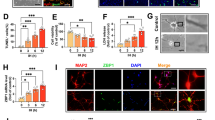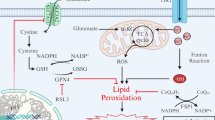Abstract
In this study, we demonstrated a decreased level of mitochondrial DNA (mtDNA) with a large number of oxidized bases in hippocampi of rats with epilepsy induced by pilocarpine. In order to verify the underlying mechanism of mtDNA impairment, we detected the response of antioxidant defense system and mitochondrial base excision repair (mtBER) pathway. Superoxide dismutase2 (SOD-2) and glutathione (GSH) were significantly decreased in the experimental group, manifesting a decreased capacity of scavenging free radicals. Mitochondrial base excision repair (mtBER) pathway, which is the main repair pathway for the removal of oxidative base modifications, displayed unbalanced expression in epileptic group. DNA polymeraseγ (polγ) increased, while apurinic/apyrimidinic endonuclease (APE1), one of mtBER initiators, decreased in mitochondria in the chronic phase of epileptogenesis. In conclusion, mtDNA was impaired during chronic recurrent seizures, whereas the endogenous antioxidants and the mtBER pathway failed to respond to the elevated mtDNA damage.





Similar content being viewed by others
Abbreviations
- mtDNA:
-
Mitochondrial DNA
- nDNA:
-
Nuclear DNA
- OXPHOS:
-
Oxidative phosphorylation
- SE:
-
Status epilepticus
- SOD:
-
Superoxide dismutase
- GSH:
-
Glutathione
- BER:
-
Base excision repair
- mtBER:
-
Mitochondrial base excision repair
- ROS:
-
Reactive oxygen species
- APE1:
-
Apurinic/apyrimidinic endonuclease1
- polγ:
-
DNA polymerase γ
- fpg:
-
Formamidopyrimidine glycosylase
- Tfam:
-
Mitochondrial transcription factor A
- SRS:
-
Spontaneous recurrent seizure
References
Acharya MM, Katyare SS (2005) Structural and functional alterations in mitochondrial membrane in picrotoxin-induced epileptic rat brain. Exp Neurol 192:79–88
Bohr VA, Stevnsner T, de Souza-Pinto NC (2002) Mitochondrial DNA repair of oxidative damage in mammalian cells. Gene 286:127–134
Chattopadhyay R, Wiederhold L, Szczesny B, Boldogh I, Hazra TK, Izumi T, Mitra S (2006) Identification and characterization of mitochondrial abasic (AP)-endonuclease in mammalian cells. Nucl Acids Res 34:2067–2076
Chechlacz M, Vemuri MC, Naegele JR (2001) Role of DNA-dependent protein kinase in neuronal survival. J Neurochem 78:141–154
Chen D, Lan J, Pei W, Chen J (2000) Detection of DNA base-excision repair activity for oxidative lesions in adult rat brain mitochondria. J Neurosci Res 61:225–236
Chuang YC, Chang AY, Lin JW, Hsu SP, Chan SH (2004) Mitochondrial dysfunction and ultrastructural damage in the hippocampus during kainic acid-induced status epilepticus in the rat. Epilepsia 45:1202–1209
Cock HR, Tong X, Hargreaves IP, Heales SJ, Clark JB, Patsalos PN, Thom M, Groves M, Schapira AH, Shorvon SD, Walker MC (2002) Mitochondrial dysfunction associated with neuronal death following status epilepticus in rat. Epilepsy Res 48:157–168
Crawford DR, Suzuki T, Sesay J, Davies KJ (2002) Analysis of gene expression following oxidative stress. Methods Mol Biol 196:155–162
Culmsee C, Bondada S, Mattson MP (2001) Hippocampal neurons of mice deficient in DNA-dependent protein kinase exhibit increased vulnerability to DNA damage, oxidative stress and excitotoxicity. Brain Res Mol Brain Res 87:257–262
Davies KJ (1995) Oxidative stress: the paradox of aerobic life. Biochem Soc Symp 61:1–31
Endres M, Biniszkiewicz D, Sobol RW, Harms C, Ahmadi M, Lipski A, Katchanov J, Mergenthaler P, Dirnagl U, Wilson SH, Meisel A, Jaenisch R (2004) Increased postischemic brain injury in mice deficient in uracil-DNA glycosylase. J Clin Invest 113:1711–1721
Fishel ML, Seo YR, Smith ML, Kelley MR (2003) Imbalancing the DNA base excision repair pathway in the mitochondria; targeting and overexpressing N-methylpurine DNA glycosylase in mitochondria leads to enhanced cell killing. Cancer Res 63:608–615
Fonnum F, Lock EA (2004) The contributions of excitotoxicity, glutathione depletion and DNA repair in chemically induced injury to neurones: exemplified with toxic effects on cerebellar granule cells. J Neurochem 88:513–531
Fortini P, Pascucci B, Parlanti E, D’Errico M, Simonelli V, Dogliotti E (2003) The base excision repair: mechanisms and its relevance for cancer susceptibility. Biochimie 85:1053–1071
Frossi B, Tell G, Spessotto P, Colombatti A, Vitale G, Pucillo C (2002) H(2)O(2) induces translocation of APE/Ref-1 to mitochondria in the Raji B-cell line. J Cell Physiol 193:180–186
Gao J, Chi ZF, Liu XW, Shan PY, Wang R (2007) Mitochondrial dysfunction and ultrastructural damage in the hippocampus of pilocarpine-induced epileptic rat. Neurosci Lett 411:152–157
Giulia C, Daniela L, Giuseppe B, Roland J, Massimo A (2008) The pilocarpine model of temporal lobe epilepsy. J Neurosci Methods 172:143–157
Gupta RC, Milatovic D, Zivin M, Dettbarn WD (2000) Seizure-induced changes in energy metabolites and effects of N-tert-butyl-alpha-phenylnitrone (PNB) and vitamin E in rats. Pflugers Arch 440:R160–R162
Harrison JF, Hollensworth SB, Spitz DR, Copeland WC, Wilson GL, LeDoux SP (2005) Oxidative stress-induced apoptosis in neurons correlates with mitochondrial DNA base excision repair pathway imbalance. Nucl Acids Res 33:4660–4671
Imam SZ, Karahalil B, Hogue BA, Souza-Pinto NC, Bohr VA (2006) Mitochondrial and nuclear DNA-repair capacity of various brain regions in mouse is altered in an age-dependent manner. Neurobiol Aging 27:1129–1136
Janssen YM, Van Houten B, Borm PJ, Mossman BT (1993) Cell and tissue responses to oxidative damage. Lab Invest 69:261–274
Jarrett SG, Liang LP, Hellier JL, Staley KJ, Patel M (2008a) Mitochondrial DNA damage and impaired base excision repair during epileptogenesis. Neurobiol Dis 30:130–138
Jarrett SG, Milder JB, Liang LP, Patel M (2008b) The ketogenic diet increases mitochondrial glutathione levels. J Neurochem 106:1044–1051
Kisby GE, Lesselroth H, Olivas A, Samson L, Gold B, Tanaka K, Turker MS (2004) Role of nucleotide- and base-excision repair in genotoxin-induced neuronal cell death. DNA Repair (Amst) 3:617–627
Kudin AP, Kudina TA, Seyfried J, Vielhaber S, Beck H, Elger CE, Kunz WS (2002) Seizure-dependent modulation of mitochondrial oxidative phosphorylation in rat hippocampus. Eur J Neurosci 15:1105–1114
Kunz WS, Kudin AP, Vielhaber S, Blumcke I, Zuschratter W, Schramm J, Beck H, Elger CE (2000) Mitochondrial complex I deficiency in the epileptic focus of patients with temporal lobe epilepsy. Ann Neurol 48:766–773
Kwon YS, Park DH, Shin EJ, Kwon MS, Ko KH, Kim WK, Jhoo JH, Jhoo WK, Wie MB, Jung BD, Kim HC (2004) Antioxidant propolis attenuates kainate-induced neurotoxicity via adenosine A1 receptor modulation in the rat. Neurosci Lett 355(3):231–235
Larsen NB, Rasmussen M, Rasmussen LJ (2005) Nuclear and mitochondrial DNA repair: similar pathways? Mitochondrion 5:89–108
Liang LP, Patel M (2004) Mitochondrial oxidative stress and increased seizure susceptibility in Sod2(−/+) mice. Free Radic Biol Med 36:542–554
Lin LH, Cao S, Yu L, Cui J, Hamilton WJ, Liu PK (2000) Up-regulation of base excision repair activity for 8-hydroxy-2′-deoxyguanosine in the mouse brain after forebrain ischemia-reperfusion. J Neurochem 74:1098–1105
Lu T, Pan Y, Kao SY, Li C, Kohane I, Chan J, Yankner BA (2004) Gene regulation and DNA damage in the ageing human brain. Nature 429:883–891
MacGregor DG, Higgins MJ, Jones PA, Maxwell WL, Watson MW, Graham DI, Stone TW (1996) Ascorbate attenuates the systemic kainate-induced neurotoxicity in the rat hippocampus. Brain Res 727:133–144
Marianne S, Christoph R (1999) Fragmented mitochondrial DNA is the predominate carrier of oxidized DNA bases. Biochemistry 38:459–464
Nakada K, Ono T, Hayashi J (2002) A novel defense system of mitochondria in mice and human subjects for preventing expression of mitochondrial dysfunction by pathogenic mutant mtDNAs. Mitochondrion 2:59–70
Nasseh IE, Amado D, Cavalheiro EA, Naffah-Mazzacoratti G, Tengan CH (2006) Investigation of mitochondrial involvement in the experimental model of epilepsy induced by pilocarpine. Epilepsy Res 68:229–239
Neema M, Navarro-Quiroga I, Chechlacz M, Gilliams-Francis K, Liu J, Lamonica K, Lin SL, Naegele JR (2005) DNA damage and nonhomologous end joining in excitotoxicity: neuroprotective role of DNA-PKcs in kainic acid-induced seizures. Hippocampus 15:1057–1071
Ono T, Isobe K, Nakada K, Hayashi JI (2001) Human cells are protected from mitochondrial dysfunction by complementation of DNA products in fused mitochondria. Nat Genet 28:272–275
Quach N, Chan T, Lu TA, Schreiber SS, Tan Z (2005) Induction of DNA repair proteins, Ref-1 and XRCC1, in adult rat brain following kainic acid-induced seizures. Brain Res 1042:236–240
Racine RJ (1972) Modification of seizure activity by electrical stimulation. II. Motor seizure. Electroencephalogr Clin Neurophysiol 32:281–294
Rao KS (2007) DNA repair in aging rat neurons. Neuroscience 145:1330–1340
Sato A, Nakada K, Hayashi J (2006) Mitochondrial dynamics and aging: mitochondrial interaction preventing individuals from expression of respiratory deficiency caused by mutant mtDNA. Biochim Biophys Acta 1763:473–481
Sobol RW, Kartalou M, Almeida KH, Joyce DF, Engelward BP, Horton JK, Prasad R, Samson LD, Wilson SH (2003) Base excision repair intermediates induce p53-independent cytotoxic and genotoxic responses. J Biol Chem 278:39951–39959
Spitz DR, Azzam EI, Li JJ, Gius D (2004) Metabolic oxidation/reduction reactions and cellular responses to ionizing radiation: a unifying concept in stress response biology. Cancer Metastasis Rev 23:311–322
Tan DX, Manchester LC, Reiter RJ, Qi W, Kim SJ, El-Sokkary GH (1998) Melatonin protects hippocampal neurons in vivo against kainic acid-induced damage in mice. J Neurosci Res 54:382–389
Tell G, Crivellato E, Pines A, Paron I, Pucillo C, Manzini G, Bandiera A, Kelley MR, Di Loreto C, Damante G (2001) Mitochondrial localization of APE/Ref-1 in thyroid cells. Mutat Res 485:143–152
Wallace DC (1992) Mitochondrial genetics: a paradigm for aging and degenerative diseases? Science 256:628–632
Walton M, Lawlor P, Sirimanne E, Williams C, Gluckman P, Dragunow M (1997) Loss of Ref-1 protein expression precedes DNA fragmentation in apoptotic neurons. Brain Res Mol Brain Res 44:167–170
Wilson DM III, McNeill DR (2007) Base excision repair and the central nervous system. Neuroscience 145:1187–1200
Acknowledgment
This study was supported by a grant from National Natural Science Foundation of China (No. 30870838).
Author information
Authors and Affiliations
Corresponding author
Rights and permissions
About this article
Cite this article
Lin, Y., Han, Y., Xu, J. et al. Mitochondrial DNA Damage and the Involvement of Antioxidant Defense and Repair System in Hippocampi of Rats with Chronic Seizures. Cell Mol Neurobiol 30, 947–954 (2010). https://doi.org/10.1007/s10571-010-9524-x
Received:
Accepted:
Published:
Issue Date:
DOI: https://doi.org/10.1007/s10571-010-9524-x




